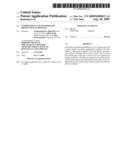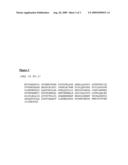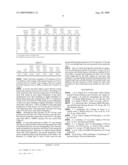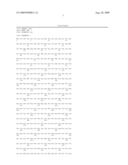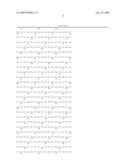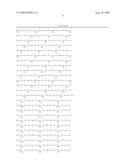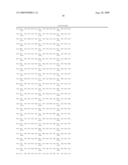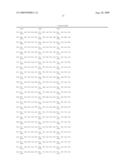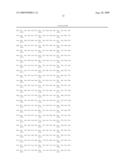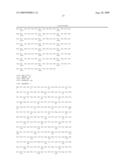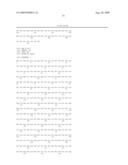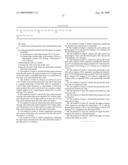Patent application title: COMPOSITIONS AND METHODS FOR PRODUCTION OF BIOFUELS
Inventors:
Chakkodabylu S. Ramesha (San Jose, CA, US)
Anil K. Joshi (North Potomac, MD, US)
Raj Subramaniam (Fremont, CA, US)
Raj Subramaniam (Fremont, CA, US)
IPC8 Class: AC12P764FI
USPC Class:
435134
Class name: Micro-organism, tissue cell culture or enzyme using process to synthesize a desired chemical compound or composition preparing oxygen-containing organic compound fat; fatty oil; ester-type wax; higher fatty acid (i.e., having at least seven carbon atoms in an unbroken chain bound to a carboxyl group); oxidized oil or fat
Publication date: 2009-08-20
Patent application number: 20090209015
Claims:
1. A method for producing fatty acids comprising the steps of:providing
genetically modified cells that express as distinct molecules:a) a
heterologous animal thioesterase-II (TE-II), andb) a heterologous animal
fatty acid synthase (FAS) or a heterologous animal FAS lacking a
thioesterase I (TE-I) domain,maintaining the cells in a media;collecting
the cells and/or the media; andextracting the fatty acids from the
genetically modified cells and/or the media.
2. The method of claim 1, wherein the fatty acids extracted from the cells and/or the media comprise C4-C14 fatty acids as free fatty acids, as esterified fatty acids, or a combination of free fatty acids and esterified fatty acids.
3. The method of claim 2, wherein an amount of any of C4-C14 fatty acids extracted from the cells and/or the media is a greater percentage of total fatty acids as compared to C4-C14 fatty acids measured as a percentage of total fatty acids produced by control cells that do not comprise a heterologous animal TE-II, a heterologous animal FAS, or a FAS lacking a TE-I domain.
4. The method of claim 1, wherein the fatty acids extracted from the cells and/or the media comprise C4-C14 fatty acids, and wherein the C4-C14 fatty acids are at least 5% of total fatty acids extracted from the cells and/or the media.
5. The method of claim 4, wherein the fatty acids extracted from the cells and/or the media comprise C4-C14 fatty acids, and wherein the C4-C14 fatty acids are at least 10% of total fatty acids extracted from the cells and/or the media.
6. The method of claim 1, further comprising converting one or more of the fatty acids extracted from the cells and/or the media to an alcohol.
7. The method of claim 1, further comprising combusting the fatty acids extracted from the cells and/or the media to provide power to a machine.
8. The method of claim 7, further comprising combusting the alcohol to provide power to a machine.
9. The method of claim 1, wherein the cells express the heterologous TE-II and the FAS lacking a TE-I domain, but not the heterologous FAS.
10. The method of claim 1, wherein the cells express the heterologous TE-II and the heterologous FAS, but not the FAS lacking a TE-I domain.
11. The method of claim 1, wherein the genetically modified cells comprise DNA sequences encoding the heterologous TE-II and the heterologous animal FAS or the heterologous animal FAS lacking a TE-I domain on an expression vector.
12. The method of claim 1, wherein the genetically modified cells comprise DNA sequences encoding the heterologous TE-II and the heterologous animal FAS or the heterologous animal FAS lacking a TE-I domain integrated into nuclear DNA or organelle DNA of the genetically modified cells.
13. The method of claim 1, wherein the genetically modified cells are eukaryotic cells.
14. The method of claim 1, wherein the genetically modified cells are prokaryotic cells.
15. The method of claim 13, wherein the eukaryotic cells are yeast cells.
16. The method of claim 14, wherein the prokaryotic cells are bacteria.
17. The method of claim 1, wherein the genetically modified cells are algae.
18. The method of claim 17, wherein the algae comprise DNA sequences encoding the heterologous TE-II and the heterologous animal FAS or the heterologous animal FAS lacking a TE-I integrated into chloroplast DNA.
19. The method of claim 17, wherein the algae are maintained in the media in a photobioreactor.
20. The method of claim 17, wherein the algae are maintained in the media in a pond.
Description:
[0001]This application claims priority to U.S. patent application No.
61/065,851, filed Feb. 15, 2008, the disclosure of which is incorporated
herein by reference.
FIELD OF THE INVENTION
[0002]The present invention relates generally biofuels, and more specifically to production of fatty acids for use as biofuels using genetically modified organisms.
BACKGROUND OF THE INVENTION
[0003]The search for biofuels as an alternate energy source is rapidly growing. Ethanol and plant derived oils are the two predominant areas of research and development in the biofuel area. Currently, most of the world's ethanol is produced by bacterial or yeast fermentation of cornstarch, but the direct and indirect costs that go into the production of ethanol barely offset the gain from its use as an alternative fuel. With respect to plant derived oils, recombinant technology has been widely used for the enhancement of oil production in higher plants. However, because of the considerable amount of land and resources required to maintain high-density plants, and because of their slow growth rate, the cost of producing biofuels using land plants in their current form is expected to be high.
[0004]The principle ingredients in plant derived oils (as well as in animal fat) are hydrocarbon chain fatty acids which often exist as glycerides or waxes. These fatty acids are synthesized in vivo from 2-carbon units (acetyl- and melonyl-CoA) by the enzyme system termed Fatty Acid Synthase (FAS). Fatty acid synthesis in plants and prokaryotes involves coordinated functioning of seven individual proteins to form a functional FAS complex (1-3). Simultaneous manipulation of all the seven genes responsible for these proteins is necessary to modulate fatty acid content in the transgenic plants. However, in contrast to prokaryotes and plants, animal FAS is a multi-domain homodimeric protein that catalyzes all the steps in fatty acid synthesis. It utilizes acetyl CoA, malonyl CoA and NADPH as substrates to catalyze sequential reactions resulting in the formation of predominantly C16 palmitic acid. The carbon chain length of fatty acids released form the active site of animal FAS is determined by thioesterase activity provided by a thioesterase domain (TE-I). Specifically, TE-I activity causes release of fatty acids when the fatty acid chain length reaches >C12, and results in the predominant production of C16 and C18 fatty acids. However, some tissues naturally make short chain fatty acids via the activity of a separate enzyme (thioesterase-II, TE-II). For example, the cells in lactating mammary glands and uropygial glands in birds express a distinct TE-II protein along with FAS (7, 8). The TE-II protein causes early chain termination resulting in the synthesis of predominantly medium-chain (C8-C12) fatty acids in these tissues. Fatty acids, and in particular short and medium (C6-C12) chain fatty acids, are desirable because of their physical properties and relatively higher caloric values and they can be used directly as biofuels. In addition, they can also be converted to their corresponding alcohols, such as hexanol and/or octanol, which are preferable for many direct commercial uses.
[0005]Over-expression of endogenous or animal FAS in E. coli, yeast, and other microbial as well as animal systems has been previously reported (4-6). However, the non-microbial systems are too costly for production of biofuels, and the reported activities of recombinant FAS proteins purified from microbial systems are very low. Recombinant technology has also been used to express fusion proteins for fatty acid synthesis. For example, Joshi, et. al., (9) disclosed expression of two chimeric fusion proteins. Each chimeric protein contained a mammalian FAS having TE-I domain deleted and replaced with a TE-II amino acid sequence. The two chimeric proteins differed from each other by the sequence and length of a linker region between the FAS ACP (acyl carrier protein) domain and TE-II amino acid sequences. Each chimeric protein was separately expressed in and purified from insect cell cultures and fatty acids were synthesized in cell free systems using the purified chimeric proteins. The fatty acid synthesis activity of the purified chimeric proteins was less than 10% of the purified recombinant rat wild type FAS. Organisms expressing either of these two fusion proteins are not considered viable tools for synthesis of fatty acids for use as biofuels. Thus, there is an ongoing need for efficient systems and methods for producing biofuels.
SUMMARY OF THE INVENTION
[0006]The present invention is based on the discovery that genetically modified cells that express as distinct molecules, a heterologous animal TE-II and a heterologous wild type animal FAS, can be used to synthesize fatty acids that are enriched for C14 and shorter carbon chain fatty acids. The genetically modified cells can also express a distinct heterologous animal FAS lacking a TE-I domain (ΔTE-I-FAS), instead of a wild type animal FAS. Accordingly, the present invention provides methods for producing fatty acid compositions enriched in C4 to C14 acids from genetically modified cells. The fatty acids produced by the genetically modified cells can be free fatty acids, or esterified fatty acids, such as glycerides. The glycerides can be monoglycerides, diglycerides, or triglycerides, and can be in the form of phosphoglycerides.
[0007]In the method of the invention, the genetically modified cells are maintained in a suitable media for a period of time to allow cells to produce fatty acids. Such fatty acids include C4-C14 fatty acids. The fatty acids produced by the genetically modified cells provided herein contain a higher percentage of C4 to C14 fatty acids than control cells. The fatty acids produced by the cells can be extracted from the cells and/or from the media and are suitable for use as biofuels. The extracted fatty acids can optionally be reduced to their corresponding alcohols, such as butanol, hexanol, octanol, decanol, dodecanol or tertadecanol.
[0008]The animal FAS and TE-II enzymes used in the method can be expressed from genes obtained from any animal. In one embodiment, the FAS and TE-II enzymes are expressed from rat genes. The ΔTE-I-FAS enzyme can also be derived from a wild type FAS expressed by any animal.
[0009]The invention also provides the genetically modified cells that are suitable for use in the method of the invention. These cells express a heterologous animal TE-II. If the cells do not normally express an endogenous animal FAS, then in addition to the heterologous animal TE-II, they also express as a distinct molecule either a heterologous wild type animal FAS or an animal ΔTE-I-FAS. The heterologous TE-II and FAS or ΔTE-I-FAS genes can be present in the genetically modified cells as DNA polynucleotides that are transiently or stably inserted into the cells.
[0010]The cells utilized in the invention can be prokaryotic or eukaryotic cells. In various non-limiting embodiments, the cells can be animal cells, bacteria cells, yeasts, or algae cells. The method is suitable for scaling such that large amounts of fatty acids can be produced for a variety of commercial applications, such as powering combustion engines, turbines, and the like.
BRIEF DESCRIPTION OF THE FIGURES
[0011]FIG. 1 provides the amino acid sequence of rat fatty acid synthase (FAS) protein (SEQ ID NO:1). As shown in FIG. 1, a TE-I deleted FAS (ΔTEI-FAS) protein can be constructed by deleting the sequence downstream of K2199 and engineering a stop codon ( ) after K2199.
[0012]FIG. 2 provides the amino acid sequence of rat thioesterase-II (TE-II) protein (SEQ ID NO:2).
[0013]FIG. 3 provides the amino acid sequence of human phosphopantetheinyl transferase (PPTase); (SEQ ID NO:3).
DESCRIPTION OF THE INVENTION
[0014]The present invention provides genetically modified cells that produce an altered fatty acid profile such that C4-C14 fatty acids make up a higher percentage of the total fatty acids, as compared to fatty acids made by cells without the genetic modification. Since C4-C14 fatty acids are suitable for use as fuels directly or via conversion to another fuel, the genetically modified cells provide an efficient source of biofuels.
[0015]The fatty acids produced by the genetically modified cells can be free fatty acids, or they may be in the form of esterified fatty acids, such as glycerides. Glycerides can be monoglycerides, diglycerides, or triglycerides, and can be in the form of phosphoglycerides. Fatty acids released from cells, such as by secretion, are predominantly free fatty acids, while cell-associated fatty acids are free fatty acids, as well as esterified forms of fatty acids. Both free fatty acids and esterified fatty acids can be used as biofuels.
[0016]The invention provides genetically modified cells that have been engineered to express heterologous proteins that are involved in fatty acid synthesis. By "heterologous" it is meant that the protein is one that is not normally encoded by the particular cell type or organism in which the protein is expressed for use in the invention.
[0017]The cells used in the invention are engineered to express a heterologous animal TE-II. While heterologous TE-II can be used as the only inserted heterologous gene to achieve an alteration in fatty acid profile produced by the cells, it is preferred that the cells are genetically modified to express the heterologous TE-II in combination with a distinct heterologous wild-type or modified animal FAS. The modified animal FAS can be an animal FAS that has been modified so that it lacks a TE-I domain (ΔTE-I-FAS).
[0018]The amino acid sequences of the heterologous animal proteins used in the method can be the same as those expressed by any animal species, or may comprise experimentally altered amino acid sequences. A variety of wild type animal FAS amino acid sequences are currently known in the art, but it is expected that animal FAS sequences hereafter identified could also be used. Some non-limiting examples of FAS proteins suitable for use in the invention include rat, chicken, human, mouse and cow FAS. The amino acid sequence of rat FAS is described in Amy et al., Proc. Natl. Acad. Sci. U.S.A. 86 (9), 3114-3118 (1989) and is also provided as NCBI Accession No. AAA41145 (Apr. 27, 1993 entry). An annotated rat FAS sequence is also provided in FIG. 1. The amino acid sequence of FAS from chicken (Gallus gallus) is provided under NCBI Accession No. J03860 (Apr. 28, 1993 entry). The amino acid sequence of human FAS is provided under NCBI Accession No. NM--004104 (Dec. 21, 2003 entry). The amino acid sequence of mouse (Mus musculus) FAS is provided under NCBI Accession No M--007988 (Mar. 5, 2006 entry). The amino acid sequence of the domestic cow (Bos Taurus) FAS is provided under NCBI Accession No AY343889 (Aug. 25, 2005 entry). The mRNA and deduced amino acid sequence of porcine FAS is also known (J. Nutr. 121, 900-907, 1991).
[0019]Animal FAS is a well characterized protein that contains seven catalytic domains. The TE-I domain is the most C-terminal of the seven. While FAS amino acid sequences may differ somewhat between animal species, each of the seven domains in any particular FAS amino acid sequence can be readily recognized by those skilled in the art. Accordingly, any TE-I domain can be identified by one skilled in the art and removed from any FAS using standard molecular biology techniques to thereby obtain a ΔTE-I-FAS. An exemplary ΔTE-I-FAS amino acid sequence is provided in FIG. 1 (SEQ ID NO:1) which is expressed from a coding sequence having an engineered stop codon after the codon for K2199. Thus, the sequence downstream (C-terminal) of K2199, which constitutes the TE-I domain, is not present in the ΔTE-I-FAS. Accordingly, amino acids 1 through 2199 shown in FIG. 1 illustrates the amino acid sequence of an exemplary ΔTE-I-FAS derived from rat FAS.
[0020]As in the case for FAS, a variety of animal TE-II amino acid sequences are currently known in the art. One example of a suitable TE-II amino acid sequence is provided in FIG. 2 (SEQ ID NO:2) which shows rat TE-II, the sequence of which was described by Naggert et. al. (Biochem. J. vol. 243, pp. 597-601, 1987). The sequence of TE II from the Uropygial gland of mallard duck is also known (Poulose A J, Rogers L, Cheesbrough T M, Kolattukudy P E. J. Biol. Chem. vol. 260(29), pp. 15953-8, 1985). TE-II from other animal sources could also be used in the present invention.
[0021]In another embodiment, in addition to animal ΔTE-I-FAS and TE-II, the invention provides for the optional expression of a heterologous wild type or mutated PPTase gene so as to increase fatty acid synthesis. In this regard, several PPTase enzymes are known to pantetheinylate apo-FAS to generate active holo-FAS. In one embodiment, the PPTase enzyme may have the same sequence as a human PPTase enzyme. The amino acid sequence for a human PPTase enzyme is provided in FIG. 3 (SEQ ID NO:3).
[0022]For the animal enzymes utilized in the present invention, it is expected that either wild type amino acid sequences, or sequences having homology with the wild type amino acid sequences could be used. In this regard, for proteins that comprise amino acid sequences that are not identical to the wild type sequences, it is considered that proteins that have at least 80% homology, and more preferably 90%, 95%, or 99% homology with the wild type sequences, could be used in the invention. Due to the well characterized nature of wild type animal FAS and TE-II proteins, those skilled in the art can determine which amino acid positions can tolerate substitutions, and what amino acid substitutions could be made at those positions using routine experimentation.
[0023]While specific amino acid sequences for examples of enzymes that can be used in the present invention are provided herein, it will be recognized that there are a multitude of DNA sequences that can encode such amino acid sequences due to the redundancy of the genetic code. Thus, cells comprising any DNA sequences encoding these enzymes are included within the scope of the invention. Further, cells comprising intronic sequences of the mammalian genes are also included, should the enzyme coding sequences used in the invention be cloned directly from mammalian genomic DNA.
[0024]The heterologous TE-II and FAS or ΔTE-I-FAS genes can be inserted into and expressed by the genetically modified cells using any suitable reagents and techniques. In general, the heterologous genes are expressed from DNA polynucleotides that have been transiently or stably inserted into the cells. For instance, for transient insertions, DNA polynucleotides encoding the heterologous genes can be expressed from one or more expression vectors that are inserted into the cells and are replicated independently of the host DNA. Suitable expression vectors can be obtained from commercial vendors or constructed in the laboratory such that the co-expression of multiple genes of interest in a desired cell type can be achieved. Such vectors can include various promoters and other regulatory elements to effect and/or optimize expression of the inserted genes. For instance, suitable expression vectors may comprise prokaryotic and/or eukaryotic promoters, enhancer elements, and selectable markers for use in maintaining one or more distinct expression vectors in the desired cell type. Some representative commercially available systems include but are not limited to, for insect cell expression: pFastBac vectors and Bac-to-Bac System (available from INVITROGEN®); for E. coli expression: pET vectors (available from NOVAGEN®) and pQE vectors (available from QIAGEN®); for S. cervisiae expression: pYES2-DEST52 expression vector (available from INVITROGEN®); for Pichia pastoris expression: Easy Select® expression kit (available from INVITOGEN®), and for algae, AlgRx® Algal Protein Expression System (available from Rincon Pharmaceuticals.)
[0025]In one embodiment, to co-express the inserted genes, the TE-II and either the FAS or the ΔTE-I-FAS and may be encoded by a single expression vector under operative control of a single or distinct promoters, which may be constitutive or inducible promoters. In the case of a single promoter, second or additional genes may be translated from, for example, an internal ribosomal entry sequence(s) from a single mRNA. Alternatively, the polynucleotide sequences encoding the enzymes may be expressed in any single cell by distinct expression vectors which may also comprise any of a wide variety of constitutive or inducible promoters, selective markers, etc.
[0026]As an alternative to co-expression of distinct proteins, a novel fusion protein provided by the invention may be translated from a single open reading frame on an mRNA, the transcription of which is driven from any of a wide variety of promoters in any suitable expression vector. For example, the invention contemplates providing a novel chimeric animal Δ-TE-I-FAS-TE-II fusion protein that comprises a novel linker sequence joining the Δ-TE-I-FAS and the TE-II such that the fatty acid profile shifts towards C4-C14 fatty acid.
[0027]DNA polynucleotides encoding the heterologous animal TE-II and FAS or ΔTE-I-FAS genes can also be stably inserted into cells by integration into the host cell DNA. One advantage of integrating the heterologous genes is that stable transformants are produced and are capable of maintaining the heterologous genes when grown in a non-selective medium. The host DNA into which the DNA polynucleotides encoding the heterologous genes are integrated can be nuclear DNA, or organelle DNA.
[0028]While the cells used to express the heterologous proteins could be cells of any species or cell type, including prokaryotic and eukaryotic cells, it is preferred to use microbial cells so that the method can be more conveniently utilized for large-scale production of biofuels. For example, it is expected that bacteria could be used to harness carbon sources, such as from sewage, in the production of fatty acids in the method of the invention. Alternatively, yeast could be used to produce the fatty acids using various fermentation apparatuses.
[0029]In one embodiment, the invention utilizes recombinant algae. Algae systems offer an advantage of decreasing the cost of biofuel production because of the rapid growth rates and inexpensive growth conditions, owing to the use of light and CO2 as the main energy source via the photosynthetic pathway. Algae are plant-like organisms without roots, stems or leaves. Algae contain chlorophyll and vary in size from microscopic forms (phytoplankton) to large seaweeds. Their habitat is fresh or salt water, or moist environments. Most algae are eukaryotic (sub-kingdom=phyciobionta), but several (e.g., cyanobacteria and prochlorophyta) are prokaryotic. Algae suitable for use in the present invention encompass both prokaryotic and eukaryotic algae, and are preferably unicellular algae. Unicellular algae are also known as microalgae. Non-limiting examples of algae that can be used in the invention include Chlorella vulgaris, which is known to secrete high levels of free fatty acids into media, and Chlamydomonas reinhardtii.
[0030]Without intending to be bound by any particular theory, it is considered that recombinant protein expression in algae is optimal for use in the invention when it takes place in the chloroplast. The heterologous DNA polynucleotides encoding the TE-II and FAS or ΔTE-I-FAS genes can be stably integrated into the chloroplast DNA of the algae by transforming the algae with one or more vectors which comprise the heterologous genes and which are targeted to the chloroplasts. Methods and vectors that can be used for integrating heterologous genes into algae chloroplast DNA by, for example, homologous recombination have been described. (See, for example, Hutchinson, et al., 1996, Chapter 9, Chloroplast transformation. Pgs. 180-196; In: Molecular Genetics of Photosynthesis, Frontiers in Molecular Biology. Anderson B., Salter A H, and Barber J. eds.: Oxford University (Davies et al. (1994) Plant Cell 6:53-63). Further, Fletcher et al. (Adv Exp Med. Biol. (2007) vol. 616, pp. 90-98) disclose optimization of recombinant protein expression in chloroplasts of green algae. In particular, Fletcher et al. describe optimization of recombinant protein expression in Chlamydomonas reinhardtii chloroplasts by employing chloroplast codon bias and manipulation of promoter and untranslated region (UTR) combinations. They also demonstrate that the C. reinhardtii chloroplast is capable of correctly folding and assembling complex mammalian proteins. Other work with algae systems also demonstrates the successful use of these organisms to efficiently express a variety of proteins (i.e., Franklin et al., Curr Opin Plant Biol. (2004) Vol. 2, pp 159-65; Mayfield, et al. PNAS (2003) Vol. 100, pp 438-442; and Heifetz, P. B. (2000) Biochimie Vol. 82, 655-666). Therefore, it is expected that algae will provide a convenient system for expressing functional proteins that catalyze improved synthesis of fatty acids according to the method of the invention.
[0031]The expression of a heterologous wild-type or modified animal FAS with a heterologous TE-II is expected to be advantageous in embodiments wherein the cells are non-animal cells, and thus do not normally exhibit endogenous animal FAS activity. For example, and without intending to be bound by any particular theory, since algae do not endogenously express a FAS that would cooperate with a heterologous animal TE-II in synthesis of fatty acids, it is preferable to express in the algae both the heterologous animal TE-II and a heterologous wild-type or modified animal FAS.
[0032]In a preferred embodiment, the heterologous TE-II and the heterologous wild-type or modified FAS are each expressed as distinct protein molecules within the cells. Thus, a method of the present invention comprises providing genetically modified cells that express a heterologous TE-II and either a heterologous FAS or a ΔTE-I-FAS, wherein the TE-II and the heterologous wild-type or ΔTE-I-FAS are expressed as distinct molecules, allowing the genetically modified cells to produce fatty acids, and collecting and/or the extracting the C4-C14 fatty acids, or any combination thereof, produced by the cells.
[0033]A convenient method of allowing the cells to produce fatty acids is to culture the cells. The amount of time and the type of apparatus in which the cells are cultured will depend on various factors that will be apparent to those skilled in the art, such as the type of cells being used, the type and volume of the culture medium, temperature, nutrient requirements, and the particular procedure that is being utilized to separate the C4-C14 fatty acids from the cells and/or the culture medium.
[0034]In one embodiment, recombinant algae according to the invention are grown in vessels suitable for commercial production of fatty acids for use as biofuels. Non-limiting examples of suitable vessels include plastic bags, and larger containers, such as vats, which may be in the form of photobioreactors. Photobioreactors can be industrial-scale culture vessels made of transparent clear materials (e.g., glass, acrylic, polycarbonate, etc) in which algae can grow and proliferate using photosynthesis to produce energy. If desired, the cultures can be mixed by either a pump or air bubbling. Alternative vessels for growing the algae include but are not limited to shallow open ponds, for example, man-made ponds suitable for holding water levels of approximately 15 to 30 cm high. Such ponds can be constructed as a loop in which the algae culture is circulated by, for instance, a paddle-wheel. Fatty acid production in microalgae has been reported at levels of from 1800-2500 gallons of oil/acre/year. It is expected that the present invention will equal or exceed such production levels.
[0035]Methods for separating and purifying fatty acids from a wide variety of cell types and cell culture media are well known in the art and can be used in performing the method of the present invention. For example, when the genetically modified cells used in the invention are algae, fatty acids can be extracted from the algae using a conventional oil press. Alternatively, the well known supercritical fluid method can be used to extract fatty acids from the cells/and or media.
[0036]If esterified fatty acids are extracted, they can be hydrolyzed (for example, using enzymatic, acid or base hydrolysis) and the free fatty acids can be separated from the glycerol using well known methods. Free fatty acids can optionally be reduced to their corresponding alcohols or hydrocarbons.
[0037]The extracted C4-C14 fatty acids and/or their alcohol derivatives can be used for producing energy that can power a machine, such as a combustion engine, a turbine, or any machine capable of being powered by combustion of the fatty acids and/or their corresponding alcohols.
[0038]It is generally considered that the invention provides for an increase in total amount (i.e., mass) of short chain fatty acids synthesized by the cells used in the method. However, the invention also facilitates an increase in relative proportion of short chain fatty acids, as compared to the total fatty acids synthesized. The increase in relative proportion of fatty acids can be an increase of from 1% to 10%, inclusive, and all including all integers between 1% and 10%. An increase in relative proportion of total fatty acids can be evidenced by an increase in the proportion of any or all of C4-C14 fatty acids relative to the total fatty acids synthesized. The total fatty acids synthesized can be measured as the sum of the individual percentages of total fatty acids (such as for C4-C18 fatty acids including C4, C6, C8, C10, C12, C14, C16:0, C16:1, C18:0 and C18:1 fatty acids). Other fatty acids that could constitute more than an insignificant amount of total fatty acids can also be measured as necessary.
[0039]In various embodiments, the invention can be used to increase the percentage of any or all of C4 to C14 fatty acids by at least 40%, 50%, 100%, 200%, 300%, 400%, and to greater than 1000%, relative to a corresponding fatty acid profile obtained from control cells (i.e., control cells that comprise an empty expression vector or express only ΔTE-I-FAS without TE-II).
[0040]In a particular embodiment, the invention provides for increasing the percentage of C8, C10, C12, and C14 fatty acids by at least 40%, 50%, 100%, 200%, 300%, 400%, and to greater than 1000%, relative to corresponding fatty acid profile obtained from control cells (i.e., control cells that comprise an empty expression vector or express only ΔTE-I-FAS without TE-II).
[0041]Relative percentages of fatty acids synthesized by cells can be determined using standard methods. For example, total lipids can be extracted from a cell pellet using the well known method of Bligh and Dyer (Bligh, E. G., and Dyer, W. J. (1959) Can. J. Biochem. Physiol, 37, 911-917). Individual fatty acids can be identified using conventional analytical tools, such as mass spectroscopy or gas chromatography. Fatty acid synthesis profiles can be compared to control cells, such as cells of the same type used in the method, but which do not express a heterologous TE-II, and/or do not express either a heterologous FAS or a ΔTE-I-FAS. The actual amount, i.e., the moles, of each particular fatty acid synthesized can also be determined using standard methods, such as by gas chromatography using internal standards.
[0042]The following Examples are meant to illustrate but not limit the invention.
EXAMPLE 1
[0043]This Example provides a description of materials and methods used for cloning Flag-wild type rat FAS, His6-ΔTE I FAS, and His6-TE II, and co-expression of the proteins in Sf9 cells.
[0044]Anti-FLAG M2 monoclonal antibody was obtained from Eastman Kodak Co. and Anti-H His 6 monoclonal antibody was obtained from CLONTECH Laboratories Inc. (Palo Alto, Calif.). Alkaline phosphatase-conjugated, goat anti-mouse IgG was purchased from Bio-Rad. The BAC-to-BAC Baculoviral expression system was purchased from Invitrogen (Carlsbad, Calif.). Vent polymerase and restriction enzymes were from New England Biolabs (Ipswich, Mass.).
[0045]cDNAs encoding Flag/His6tagged-wild type rat FAS and expression of recombinant proteins in Sf9 cells was performed using known techniques. Briefly, the His6-tagged ΔTE I-FAS construct was generated by deleting the whole TE I domain coding sequence of a rat wild type FAS construct (summarized in FIG. 1) and substituting the ACP domain (which is the domain immediately preceding the TE-I domain in the C-terminal direction) with PCR amplified ACP domain sequence carrying a C-terminal STOP codon, using standard cloning techniques. The sequence and location of the primers used to amplify rat ACP substitution fragment are described in Table 1. In Table 1, uppercase letters indicate that primer sequences are identical to cDNA sequence, while bases in lowercase are not present in cDNA and were incorporated into the oligomers in order to engineer restriction sites at the ends of amplified fragments. Restriction sites used for cloning are shown in italics and stop codons are shown in bold. T or B in oligomer names indicates sense/antisense oligomer, respectively. The base pair numbers for ΔTE I-FAS primers are according to the rat FAS cDNA sequence published in Amy et al (1989) Proc. Natl. Acad. Sci. USA 86, 3114-3118), while those for TE II primers are according to the rat TE II sequence published in Naggert et. al. (1987) Biochem. J. 243, 597-601.
TABLE-US-00001 TABLE 1 Primer Sequence Location ΔTE I-FAS Primers 200T6080 5'-catatctaGACAGGGCGACCCGGGAAGCCTGTCCT 6070-6096 (SEQ ID NO:4) Xba I Xma I 1B6665 5'-atatgcggccgcatcCTTGGGGGCTGCCAACTCAGTGTCTG 6653-6678 (SEQ ID NO:5) Not I TE II Primers TE2T1 5'-atgctagcgcgcATGGAGACCGCTGTTAACGCTA 1-22 (SEQ ID NO:6) BssH II TE2B1 5'-tgatagcggccgcTCAAGTGAGTGACGAGAGTTCCA 770-729 (SEQ ID NO:7) Not I
[0046]The coding sequence of the rat TE-II was amplified by PCR using TE II carrying plasmid 233.FB as the template DNA and Vent polymerase as described earlier (Joshi, et al. (1993) Biochem. J. vol. 296, pp. 143-149). The sequence and location of the primers used to amplify rat TE-II are described in Table 1. The sense and antisense primers carried BssH2 and NotI restriction enzyme recognition sites that were used to clone the amplified DNA, in frame, down stream of the His6 recognition sequence modified pFASTBAC vector using standard cloning techniques. The DNA sequence of the cloned TE-II gene was confirmed by DNA sequencing, and used to generate recombinant Baculoviral stocks by a conventional transposition method, using the BAC-to-BAC Baculoviral expression system (Invitrogen) according to the manufacturer's instructions.
[0047]All three recombinant viral stocks (TE-II, FAS and ΔTE I-FAS) were titrated before use. For protein expression Sf9 cells (˜1×106 cells/ml grown in EX-CELL 420 serum free media; SAFC Biosciences) were infected with the recombinant viruses (at specified M.O.I.) and cultured for 48 h at 27° C. SDS PAGE and Western blot analysis of cell lysates using tag specific primary antibody confirmed expression of each protein. For co-expression experiments, the cells were infected with various combinations of recombinant viruses for 48 hr, harvested by centrifugation and used for fatty acid analysis.
EXAMPLE 2
[0048]This Example provides demonstrations of elevated synthesis of C14 and shorter fatty acids achieved by the invention using an insect cell/baculovirus system constructed and used to express the proteins as described in Example 1. The fatty acid content summarized in Table 2 and Table 3 below was determined using conventional methods. Briefly, total lipids from pelleted cells were extracted by the method of Bligh and Dyer (Bligh, E. G., and Dyer, W. J. (1959) Can. J. Biochem. Physiol, 37, 911-917). Esterified fatty acids in the total lipid extract were hydrolyzed using 0.2M KOH, and the free fatty acids were derivatized to pentafluorobenzyl esters and analyzed by gas chromatography-mass spectroscopy (GC-MS) as described by Ramesha and Taylor (Ramesha, C. S., and Taylor, L. A. (1991) Analytical Biochem. 192, 173-190). Individual fatty acids were identified using standards and mass spectra. The concentration of each fatty acid was expressed as the percent of the total fatty acids. Fatty acids longer than C18 were less than 0.02% of the total under the culture conditions and were ignored. The results of fatty acid analysis are as provided in Table 2 and Table 3. Parenthesis indicates multiplicity of infection (M.O.I.).
TABLE-US-00002 TABLE 2 Control-2 TE-II + TE-II + TE-II + Control-1 (ΔTE- TE-II ΔTE-I- ΔTE-I- ΔTE-I- TE-II + TE-II + (empty I-FAS only FAS FAS FAS FAS FAS vector) alone) (100)a (100 + 100) (25 + 50) (25 + 100) (25 + 50) (25 + 100) C8 ND* 0.001 0.46 0.61 0.084 0.184 0.442 0.156 C10 ND 0.074 0.89 0.6 0.381 0.412 0.594 0.378 C12 0.59 0.489 5.9 3.62 2.302 2.425 2.424 2.235 C14 ND 0.312 4.02 2.95 0.874 0.883 0.928 0.859 C16:1 27.3 28.992 22.47 24.01 26.489 25.932 27.343 27.389 C16:0 5.07 4.604 5.54 5.26 5.473 5.261 5.756 5.393 C18:1 49.6 52.3 45.47 48.39 48.599 49.441 46.663 47.355 C18:0 16.9 13.229 14.75 14.1 15.797 15.462 15.851 16.236 A 0.59 0.876 11.27 7.78 3.641 3.904 4.388 3.628 B 0.733 A: % increase in C8 to C14 fatty acids B: Average % increase of control 1 and control 2
TABLE-US-00003 TABLE 3 TE-II + TE-II + TE-II + ΔTE-I- ΔTE-I- ΔTE-I- TE-II + TE-II + TE-II FAS FAS FAS FAS FAS Control (100) (100:100) (25:50) (25:100) (25:50) (25:100) 100% 1538% 1061% 497% 533% 599% 495%
[0049]Table 3 provides a summary of % increase in C8 to C14 relative to the average of the percent increase in C8:0 to C14:0 for the two controls. The average of the two controls (0.733% increase) is set to 100%, as shown for "Control" in Table 3.
[0050]It can be seen from Tables 2 and 3 that the control insect cells contain very low levels of C8 to C14 totaling <1% of the total fatty acids. However, expression of TE-II alone in these cells results in early chain termination of the native (endogenous) FAS, thus resulting in a higher abundance of shorter chain fatty acids, totaling about 10%. Co-expression of both ΔTE-I-FAS and TE-II also results in early termination of fatty acid chain resulting in higher abundance of shorter chain fatty acids (up to ˜10%). In addition to the early chain termination of fatty acids in TE-II alone and TE-II+ΔTE-I-FAS expressing cells, cells expressing wild type FAS along with TE-II also show early chain termination.
[0051]Although the total amounts of C8-C14 fatty acids produced are less than 15% of the total fatty acids, the absolute increase in the short chain fatty acids (C8 to C14) represents from 400 to >1000% increase over the control cells (Table 3).
[0052]For the data presented in Tables 2-3, pre-existing and newly synthesized fatty acids following expression of the recombinant proteins were not distinguished. Also, the fatty acids accumulation occurred for only about 36 hrs during the 48 hr infection period. Therefore, it is likely that the shorter chain fatty acids represent a far greater proportion of the newly synthesized fatty acids than shown in the Tables. Furthermore, it is likely that C4 and C6 fatty acids are also formed following the expression of TE-II and ΔTE-I-FAS and TE-II, even though they were not measured in this particular case.
[0053]Thus, it is clear from the above data that, by expression of a heterologous animal TE-II alone or such a TE-II in association with a heterologous wild type or modified FAS, it is possible to increase the proportion of short C4-C14 fatty acids synthesized by the cells, relative to total fatty acid synthesis. It is expected that the method of the invention could be performed in any suitable cell type with similar results, and indicates that the invention will be useful for large scale production of short chain fatty acids suitable for use as biofuels.
REFERENCES
[0054]1. D. G. Hardie, & A. D. McCarthy (1986) in Mutidomain Proteins-Structure and Evolution, eds. Hardie, D. G. & Coggins, J. R. (Elsevier, Amsterdam), pp. 229-258. [0055]2. S. Smith (2006) Science, Vol. 311, pp 1251-1252 [0056]3. S. Smith, FASEB J. (1994) vol. 8, pp. 1248-59 [0057]4. E. Schweizer and J. Hofmann (2004) Microbiology and Molecular Biology Reviews, Vil. 68, pp. 501-517 and references therein [0058]5. V. Jayakumar, W-Y Huang, B. Raetz, S. S. Chirala, and S. J. Wakil (1996) Proc. Natl. Acad. Sci. USA. Vol. 93, pp. 14509-14514. [0059]6. A. K. Joshi, S. Smith (1993) Biochem. J. vol. 296, pp. 143-149. [0060]7. L. Libertini, C-Y. Lin, and S. Smith, (1976) Fed. Proc. 35.1671 and references therein. [0061]8. J. S. Buckner, and P. E. Kolattukudy, (1976) in Chemistry and Biochemistry of Natural Waxes (Kolattukudy, P. E., ed) pp. 147-200, Elsevier, New York [0062]9. A. K. Joshi, et al (2005) Biochemistry, Vol. 44, pp 4100-4107 [0063]10. M. Kates, (1986) Techniques of Lipidology, 2nd Revised Edition, Elsevier Publications.
Sequence CWU
1
312444PRTRat 1Met Glu Glu Val Val Ile Ala Gly Met Ser Gly Lys Leu Pro Glu
Ser1 5 10 15Glu Asn Leu
Gln Glu Phe Trp Ala Asn Leu Ile Gly Gly Val Asp Met 20
25 30Val Thr Asp Asp Asp Arg Arg Trp Lys Ala
Gly Leu Tyr Gly Leu Pro 35 40
45Lys Arg Ser Gly Lys Leu Lys Asp Leu Ser Lys Phe Asp Ala Ser Phe 50
55 60Phe Gly Val His Pro Lys Gln Ala His
Thr Met Asp Pro Gln Leu Arg65 70 75
80Leu Leu Leu Glu Val Ser Tyr Glu Ala Ile Val Asp Gly Gly
Ile Asn 85 90 95Pro Ala
Ser Leu Arg Gly Thr Asn Thr Gly Val Trp Val Gly Val Ser 100
105 110Gly Ser Glu Ala Ser Glu Ala Leu Ser
Arg Asp Pro Glu Thr Leu Leu 115 120
125Gly Tyr Ser Met Val Gly Cys Gln Arg Ala Met Met Ala Asn Arg Leu
130 135 140Ser Phe Phe Phe Asp Phe Lys
Gly Pro Ser Ile Ala Leu Asp Thr Ala145 150
155 160Cys Ser Ser Ser Leu Leu Ala Leu Gln Asn Ala Tyr
Gln Ala Ile Arg 165 170
175Ser Gly Glu Cys Pro Ala Ala Thr Val Gly Gly Ile Asn Leu Leu Leu
180 185 190Lys Pro Asn Thr Ser Val
Gln Phe Met Lys Leu Gly Met Leu Ser Pro 195 200
205Asp Gly Thr Cys Arg Ser Phe Asp Asp Ser Gly Asn Gly Tyr
Cys Arg 210 215 220Ala Glu Ala Val Val
Ala Val Leu Leu Thr Lys Lys Ser Leu Ala Arg225 230
235 240Arg Val Tyr Ala Thr Ile Leu Asn Ala Gly
Thr Asn Thr Asp Gly Cys 245 250
255Lys Glu Gln Gly Val Thr Phe Pro Ser Gly Glu Ala Gln Glu Gln Leu
260 265 270Ile Arg Ser Leu Tyr
Gln Pro Gly Gly Val Ala Pro Glu Ser Leu Glu 275
280 285Tyr Ile Glu Ala His Gly Thr Gly Thr Lys Val Gly
Asp Pro Gln Glu 290 295 300Leu Asn Gly
Ile Thr Arg Ser Leu Cys Ala Phe Arg Gln Ser Pro Leu305
310 315 320Leu Ile Gly Ser Thr Lys Ser
Asn Met Gly His Pro Glu Pro Ala Ser 325
330 335Gly Leu Ala Ala Leu Thr Lys Val Leu Leu Ser Leu
Glu Asn Gly Val 340 345 350Trp
Ala Pro Asn Leu His Phe His Asn Pro Asn Pro Glu Ile Pro Ala 355
360 365Leu Leu Asp Gly Arg Leu Gln Val Val
Asp Arg Pro Leu Pro Val Arg 370 375
380Gly Gly Ile Val Gly Ile Asn Ser Phe Gly Phe Gly Gly Ala Asn Val385
390 395 400His Val Ile Leu
Gln Pro Asn Thr Gln Gln Ala Pro Ala Pro Ala Pro 405
410 415His Ala Ala Leu Pro His Leu Leu His Ala
Ser Gly Arg Thr Met Glu 420 425
430Ala Val Gln Gly Leu Leu Glu Gln Gly Arg Gln His Ser Gln Asp Leu
435 440 445Ala Phe Val Ser Met Leu Asn
Asp Ile Ala Ala Thr Pro Thr Ala Ala 450 455
460Met Pro Phe Arg Gly Tyr Thr Val Leu Gly Val Glu Gly His Val
Gln465 470 475 480Glu Val
Gln Gln Val Pro Ala Ser Gln Arg Pro Leu Trp Phe Ile Cys
485 490 495Ser Gly Met Gly Thr Gln Trp
Arg Gly Met Gly Leu Ser Leu Met Arg 500 505
510Leu Asp Ser Phe Arg Glu Ser Ile Leu Arg Ser Asp Glu Ala
Leu Lys 515 520 525Pro Leu Gly Val
Lys Val Ser Asp Leu Leu Leu Ser Thr Asp Glu His 530
535 540Thr Phe Asp Asp Ile Val His Ser Phe Val Ser Leu
Thr Ala Ile Gln545 550 555
560Ile Ala Leu Ile Asp Leu Leu Thr Ser Met Gly Leu Lys Pro Asp Gly
565 570 575Ile Ile Gly His Ser
Leu Gly Glu Val Ala Cys Gly Tyr Ala Asp Gly 580
585 590Cys Leu Ser Gln Arg Glu Ala Val Leu Ala Ala Tyr
Trp Arg Gly Gln 595 600 605Cys Ile
Lys Asp Ala Asn Leu Pro Ala Gly Ser Met Ala Ala Val Gly 610
615 620Leu Ser Trp Glu Glu Cys Lys Gln Arg Cys Pro
Pro Gly Val Val Pro625 630 635
640Ala Cys His Asn Ser Glu Asp Thr Val Thr Ile Ser Gly Pro Gln Ala
645 650 655Ala Val Asn Glu
Phe Val Glu Gln Leu Lys Gln Glu Gly Val Phe Ala 660
665 670Lys Glu Val Arg Thr Gly Gly Leu Ala Phe His
Ser Tyr Phe Met Glu 675 680 685Gly
Ile Ala Pro Thr Leu Leu Gln Ala Leu Lys Lys Val Ile Arg Glu 690
695 700Pro Arg Pro Arg Ser Ala Arg Trp Leu Ser
Thr Ser Ile Pro Glu Ala705 710 715
720Gln Trp Gln Ser Ser Leu Ala Arg Thr Ser Ser Ala Glu Tyr Asn
Val 725 730 735Asn Asn Leu
Val Ser Pro Val Leu Phe Gln Glu Ala Leu Trp His Val 740
745 750Pro Glu His Ala Val Val Leu Glu Ile Ala
Pro His Ala Leu Leu Gln 755 760
765Ala Val Leu Lys Arg Gly Val Lys Pro Ser Cys Thr Ile Ile Pro Leu 770
775 780Met Lys Arg Asp His Lys Asp Asn
Leu Glu Phe Phe Leu Thr Asn Leu785 790
795 800Gly Lys Val His Leu Thr Gly Ile Asp Ile Asn Pro
Asn Ala Leu Phe 805 810
815Pro Pro Val Glu Phe Pro Val Pro Arg Gly Thr Pro Leu Ile Ser Pro
820 825 830His Ile Lys Trp Asp His
Ser Gln Thr Trp Asp Ile Pro Val Ala Glu 835 840
845Asp Phe Pro Asn Gly Ser Ser Ser Ser Ser Ala Thr Val Tyr
Asn Ile 850 855 860Asp Ala Ser Ser Glu
Ser Ser Asp His Tyr Leu Val Asp His Cys Ile865 870
875 880Asp Gly Arg Val Leu Phe Pro Gly Thr Gly
Tyr Leu Tyr Leu Val Trp 885 890
895Lys Thr Leu Ala Arg Ser Leu Ser Leu Ser Leu Glu Glu Thr Pro Val
900 905 910Val Phe Glu Asn Val
Thr Phe His Gln Ala Thr Ile Leu Pro Arg Thr 915
920 925Gly Thr Val Pro Leu Glu Val Arg Leu Leu Glu Ala
Ser His Ala Phe 930 935 940Glu Val Ser
Asp Ser Gly Asn Leu Ile Val Ser Gly Lys Val Tyr Gln945
950 955 960Trp Glu Asp Pro Asp Ser Lys
Leu Phe Asp His Pro Glu Val Pro Ile 965
970 975Pro Ala Glu Ser Glu Ser Val Ser Arg Leu Thr Gln
Gly Glu Val Tyr 980 985 990Lys
Glu Leu Arg Leu Arg Gly Tyr Asp Tyr Gly Pro His Phe Gln Gly 995
1000 1005Val Tyr Glu Ala Thr Leu Glu Gly
Glu Gln Gly Lys Leu Leu Trp 1010 1015
1020Lys Asp Asn Trp Val Thr Phe Met Asp Thr Met Leu Gln Ile Ser
1025 1030 1035Ile Leu Gly Phe Ser Lys
Gln Ser Leu Gln Leu Pro Thr Arg Val 1040 1045
1050Thr Ala Ile Tyr Ile Asp Pro Ala Thr His Leu Gln Lys Val
Tyr 1055 1060 1065Met Leu Glu Gly Asp
Thr Gln Val Ala Asp Val Thr Thr Ser Arg 1070 1075
1080Cys Leu Gly Val Thr Val Ser Gly Gly Val Tyr Ile Ser
Arg Leu 1085 1090 1095Gln Thr Thr Ala
Thr Ser Arg Arg Gln Gln Glu Gln Leu Val Pro 1100
1105 1110Thr Leu Glu Lys Phe Val Phe Thr Pro His Val
Glu Pro Glu Cys 1115 1120 1125Leu Ser
Glu Ser Ala Ile Leu Gln Lys Glu Leu Gln Leu Cys Lys 1130
1135 1140Gly Leu Ala Lys Ala Leu Gln Thr Lys Ala
Thr Gln Gln Gly Leu 1145 1150 1155Lys
Met Thr Val Pro Gly Leu Glu Asp Leu Pro Gln His Gly Leu 1160
1165 1170Pro Arg Leu Leu Ala Ala Ala Cys Gln
Leu Gln Leu Asn Gly Asn 1175 1180
1185Leu Gln Leu Glu Leu Gly Glu Val Leu Ala Arg Glu Arg Leu Leu
1190 1195 1200Leu Pro Glu Asp Pro Leu
Ile Ser Gly Leu Leu Asn Ser Gln Ala 1205 1210
1215Leu Lys Ala Cys Ile Asp Thr Ala Leu Glu Asn Leu Ser Thr
Leu 1220 1225 1230Lys Met Lys Val Val
Glu Val Leu Ala Gly Glu Gly His Leu Tyr 1235 1240
1245Ser His Ile Ser Ala Leu Leu Asn Thr Gln Pro Met Leu
Gln Leu 1250 1255 1260Glu Tyr Thr Ala
Thr Asp Arg His Pro Gln Ala Leu Lys Asp Val 1265
1270 1275Gln Thr Lys Leu Gln Gln His Asp Val Ala Gln
Gly Gln Trp Asp 1280 1285 1290Pro Ser
Gly Pro Ala Pro Thr Asn Leu Gly Ala Leu Asp Leu Val 1295
1300 1305Val Cys Asn Cys Ala Leu Ala Thr Leu Gly
Asp Pro Ala Leu Ala 1310 1315 1320Leu
Asp Asn Met Val Ala Ala Leu Lys Asp Gly Gly Phe Leu Leu 1325
1330 1335Met His Thr Val Leu Lys Gly His Ala
Leu Gly Glu Thr Leu Ala 1340 1345
1350Cys Leu Pro Ser Glu Val Gln Pro Gly Pro Ser Phe Leu Ser Gln
1355 1360 1365Glu Glu Trp Glu Ser Leu
Phe Ser Arg Lys Ala Leu His Leu Val 1370 1375
1380Gly Leu Lys Lys Ser Phe Tyr Gly Thr Ala Leu Phe Leu Cys
Arg 1385 1390 1395Arg Leu Ser Pro Gln
Asp Lys Pro Ile Phe Leu Pro Val Glu Asp 1400 1405
1410Thr Ser Phe Gln Trp Val Asp Ser Leu Lys Ser Ile Leu
Ala Thr 1415 1420 1425Ser Ser Ser Gln
Pro Val Trp Leu Thr Ala Met Asn Cys Pro Thr 1430
1435 1440Ser Gly Val Val Gly Leu Val Asn Cys Leu Arg
Lys Glu Pro Gly 1445 1450 1455Gly His
Arg Ile Arg Cys Ile Leu Leu Ser Asn Leu Ser Ser Thr 1460
1465 1470Ser His Val Pro Lys Leu Asp Pro Gly Ser
Ser Glu Leu Gln Lys 1475 1480 1485Val
Leu Glu Ser Asp Leu Val Met Asn Val Tyr Arg Asp Gly Ala 1490
1495 1500Trp Gly Ala Phe Arg His Phe Gln Leu
Glu Gln Asp Lys Pro Glu 1505 1510
1515Glu Gln Thr Ala His Ala Phe Val Asn Val Leu Thr Arg Gly Asp
1520 1525 1530Leu Ala Ser Ile Arg Trp
Val Ser Ser Pro Leu Lys His Met Gln 1535 1540
1545Pro Pro Ser Ser Ser Gly Ala Gln Leu Cys Thr Val Tyr Tyr
Ala 1550 1555 1560Ser Leu Asn Phe Arg
Asp Ile Met Leu Ala Thr Gly Lys Leu Ser 1565 1570
1575Pro Asp Ala Ile Pro Gly Lys Trp Ala Ser Arg Asp Cys
Met Leu 1580 1585 1590Gly Met Glu Phe
Ser Gly Arg Asp Lys Cys Gly Arg Arg Val Met 1595
1600 1605Gly Leu Val Pro Ala Glu Gly Leu Ala Thr Ser
Val Leu Leu Ser 1610 1615 1620Pro Asp
Phe Leu Trp Asp Val Pro Ser Ser Trp Thr Leu Glu Glu 1625
1630 1635Ala Ala Ser Val Pro Val Val Tyr Thr Thr
Ala Tyr Tyr Ser Leu 1640 1645 1650Val
Val Arg Gly Arg Ile Gln His Gly Glu Thr Val Leu Ile His 1655
1660 1665Ser Gly Ser Gly Gly Val Gly Gln Ala
Ala Ile Ser Ile Ala Leu 1670 1675
1680Ser Leu Gly Cys Arg Val Phe Thr Thr Val Gly Ser Ala Glu Lys
1685 1690 1695Arg Ala Tyr Leu Gln Ala
Arg Phe Pro Gln Leu Asp Asp Thr Ser 1700 1705
1710Phe Ala Asn Ser Arg Asp Thr Ser Phe Glu Gln His Val Leu
Leu 1715 1720 1725His Thr Gly Gly Lys
Gly Val Asp Leu Val Leu Asn Ser Leu Ala 1730 1735
1740Glu Glu Lys Leu Gln Ala Ser Val Arg Cys Leu Ala Gln
His Gly 1745 1750 1755Arg Phe Leu Glu
Ile Gly Lys Phe Asp Leu Ser Asn Asn His Pro 1760
1765 1770Leu Gly Met Ala Ile Phe Leu Lys Asn Val Thr
Phe His Gly Ile 1775 1780 1785Leu Leu
Asp Ala Leu Phe Glu Gly Ala Asn Asp Ser Trp Arg Glu 1790
1795 1800Val Ala Glu Leu Leu Lys Ala Gly Ile Arg
Asp Gly Val Val Lys 1805 1810 1815Pro
Leu Lys Cys Thr Val Phe Pro Lys Ala Gln Val Glu Asp Ala 1820
1825 1830Phe Arg Tyr Met Ala Gln Gly Lys His
Ile Gly Lys Val Leu Val 1835 1840
1845Gln Val Arg Glu Glu Glu Pro Glu Ala Met Leu Pro Gly Ala Gln
1850 1855 1860Pro Thr Leu Ile Ser Ala
Ile Ser Lys Thr Phe Cys Pro Glu His 1865 1870
1875Lys Ser Tyr Ile Ile Thr Gly Gly Leu Gly Gly Phe Gly Leu
Glu 1880 1885 1890Leu Ala Arg Trp Leu
Val Leu Arg Gly Ala Gln Arg Leu Val Leu 1895 1900
1905Thr Ser Arg Ser Gly Ile Arg Thr Gly Tyr Gln Ala Lys
His Val 1910 1915 1920Arg Glu Trp Arg
Arg Gln Gly Ile His Val Leu Val Ser Thr Ser 1925
1930 1935Asn Val Ser Ser Leu Glu Gly Ala Arg Ala Leu
Ile Ala Glu Ala 1940 1945 1950Thr Lys
Leu Gly Pro Val Gly Gly Val Phe Asn Leu Ala Met Val 1955
1960 1965Leu Arg Asp Ala Met Leu Glu Asn Gln Thr
Pro Glu Leu Phe Gln 1970 1975 1980Asp
Val Asn Lys Pro Lys Tyr Asn Gly Thr Leu Asn Leu Asp Arg 1985
1990 1995Ala Thr Arg Glu Ala Cys Pro Glu Leu
Asp Tyr Phe Val Ala Phe 2000 2005
2010Ser Ser Val Ser Cys Gly Arg Gly Asn Ala Gly Gln Ser Asn Tyr
2015 2020 2025Gly Phe Ala Asn Ser Thr
Met Glu Arg Ile Cys Glu Gln Arg Arg 2030 2035
2040His Asp Gly Leu Pro Gly Leu Ala Val Gln Trp Gly Ala Ile
Gly 2045 2050 2055Asp Val Gly Ile Ile
Leu Glu Ala Met Gly Thr Asn Asp Thr Val 2060 2065
2070Val Gly Gly Thr Leu Pro Gln Arg Ile Ser Ser Cys Met
Glu Val 2075 2080 2085Leu Asp Leu Phe
Leu Asn Gln Pro His Ala Val Leu Ser Ser Phe 2090
2095 2100Val Leu Val Glu Lys Lys Ala Val Ala His Gly
Asp Gly Glu Ala 2105 2110 2115Gln Arg
Asp Leu Val Lys Ala Val Ala His Ile Leu Gly Ile Arg 2120
2125 2130Asp Leu Ala Gly Ile Asn Leu Asp Ser Ser
Leu Ala Asp Leu Gly 2135 2140 2145Leu
Asp Ser Leu Met Gly Val Glu Val Arg Gln Ile Leu Glu Arg 2150
2155 2160Glu His Asp Leu Val Leu Pro Ile Arg
Glu Val Arg Gln Leu Thr 2165 2170
2175Leu Arg Lys Leu Gln Glu Met Ser Ser Lys Ala Gly Ser Asp Thr
2180 2185 2190Glu Leu Ala Ala Pro Lys
Ser Lys Asn Asp Thr Ser Leu Lys Gln 2195 2200
2205Ala Gln Leu Asn Leu Ser Ile Leu Leu Val Asn Pro Glu Gly
Pro 2210 2215 2220Thr Leu Thr Arg Leu
Asn Ser Val Gln Ser Ser Glu Arg Pro Leu 2225 2230
2235Phe Leu Val His Pro Ile Glu Gly Ser Ile Thr Val Phe
His Ser 2240 2245 2250Leu Ala Ala Lys
Leu Ser Val Pro Thr Tyr Gly Leu Gln Cys Thr 2255
2260 2265Gln Ala Ala Pro Leu Asp Ser Ile Pro Asn Leu
Ala Tyr Thr Gln 2270 2275 2280Ser Tyr
Arg Ala Lys Leu Thr Pro Gly Cys Glu Ala Glu Ala Glu 2285
2290 2295Ala Glu Ala Ile Cys Phe Phe Ile Lys Gln
Phe Val Asp Ala Glu 2300 2305 2310His
Ser Lys Val Leu Glu Ala Leu Leu Pro Leu Lys Ser Leu Glu 2315
2320 2325Asp Arg Val Ala Ala Ala Val Asp Leu
Ile Thr Arg Ser His Gln 2330 2335
2340Ser Leu Asp Arg Arg Asp Leu Ser Phe Ala Ala Val Ser Phe Tyr
2345 2350 2355Tyr Lys Leu Arg Ala Ala
Asp Gln Tyr Lys Pro Lys Ala Lys Tyr 2360 2365
2370His Gly Asn Val Ile Leu Leu Arg Ala Lys Thr Gly Gly Thr
Tyr 2375 2380 2385Gly Glu Asp Leu Gly
Ala Asp Tyr Asn Leu Ser Gln Val Cys Asp 2390 2395
2400Gly Lys Val Ser Val His Ile Ile Glu Gly Asp His Arg
Thr Leu 2405 2410 2415Leu Glu Gly Arg
Gly Leu Glu Ser Ile Ile Asn Ile Ile His Ser 2420
2425 2430Ser Leu Ala Glu Pro Arg Val Ser Val Arg Glu
2435 24402263PRTRat 2Met Glu Thr Ala Val Asn Ala Lys Ser
Pro Arg Asn Glu Lys Val Leu1 5 10
15Asn Cys Leu Tyr Gln Asn Pro Asp Ala Val Phe Lys Leu Ile Cys
Phe 20 25 30Pro Trp Ala Gly
Gly Gly Ser Ile His Phe Ala Lys Trp Gly Gln Lys 35
40 45Ile Asn Asp Ser Leu Glu Val His Ala Val Arg Leu
Ala Gly Arg Glu 50 55 60Thr Arg Leu
Gly Glu Pro Phe Ala Asn Asp Ile Tyr Gln Ile Ala Asp65 70
75 80Glu Ile Val Thr Ala Leu Leu Pro
Ile Ile Gln Asp Lys Ala Phe Ala 85 90
95Phe Phe Gly His Ser Phe Gly Ser Tyr Ile Ala Leu Ile Thr
Ala Leu 100 105 110Leu Leu Lys
Glu Lys Tyr Lys Met Glu Pro Leu His Ile Phe Val Ser 115
120 125Gly Ala Ser Ala Pro His Ser Thr Ser Arg Pro
Gln Val Pro Asp Leu 130 135 140Asn Glu
Leu Thr Glu Glu Gln Val Arg His His Leu Leu Asp Phe Gly145
150 155 160Gly Thr Pro Lys His Leu Ile
Glu Asp Gln Asp Val Leu Arg Met Phe 165
170 175Ile Pro Leu Leu Lys Ala Asp Ala Gly Val Val Lys
Lys Phe Ile Phe 180 185 190Asp
Lys Pro Ser Lys Ala Leu Leu Ser Leu Asp Ile Thr Gly Phe Leu 195
200 205Gly Ser Glu Asp Thr Ile Lys Asp Ile
Glu Gly Trp Gln Asp Leu Thr 210 215
220Ser Gly Lys Phe Asp Val His Met Leu Pro Gly Asp His Phe Tyr Leu225
230 235 240Met Lys Pro Asp
Asn Glu Asn Phe Ile Lys Asn Tyr Ile Ala Lys Cys 245
250 255Leu Glu Leu Ser Ser Leu Thr
2603309PRTHuman 3Met Val Phe Pro Ala Lys Arg Phe Cys Leu Val Pro Ser Met
Glu Gly1 5 10 15Val Arg
Trp Ala Phe Ser Cys Gly Thr Trp Leu Pro Ser Arg Ala Glu 20
25 30Trp Leu Leu Ala Val Arg Ser Ile Gln
Pro Glu Glu Lys Glu Arg Ile 35 40
45Gly Gln Phe Val Phe Ala Arg Asp Ala Lys Ala Ala Met Ala Gly Arg 50
55 60Leu Met Ile Arg Lys Leu Val Ala Glu
Lys Leu Asn Ile Pro Trp Asn65 70 75
80His Ile Arg Leu Gln Arg Thr Ala Lys Gly Lys Pro Val Leu
Ala Lys 85 90 95Asp Ser
Ser Asn Pro Tyr Pro Asn Phe Asn Phe Asn Ile Ser His Gln 100
105 110Gly Asp Tyr Ala Val Leu Ala Ala Glu
Pro Glu Leu Gln Val Gly Ile 115 120
125Asp Ile Met Lys Thr Ser Phe Pro Gly Arg Gly Ser Ile Pro Glu Phe
130 135 140Phe His Ile Met Lys Arg Lys
Phe Thr Asn Lys Glu Trp Glu Thr Ile145 150
155 160Arg Ser Phe Lys Asp Glu Trp Thr Gln Leu Asp Met
Phe Tyr Arg Asn 165 170
175Trp Ala Leu Lys Glu Ser Phe Ile Lys Ala Ile Gly Val Gly Leu Gly
180 185 190Phe Glu Leu Gln Arg Leu
Glu Phe Asp Leu Ser Pro Leu Asn Leu Asp 195 200
205Ile Gly Gln Val Tyr Lys Glu Thr Arg Leu Phe Leu Asp Gly
Glu Glu 210 215 220Glu Lys Glu Trp Ala
Phe Glu Glu Ser Lys Ile Asp Glu His His Phe225 230
235 240Val Ala Val Ala Leu Arg Lys Pro Asp Gly
Ser Arg His Gln Asp Val 245 250
255Pro Ser Gln Asp Asp Ser Lys Pro Thr Gln Arg Gln Phe Thr Ile Leu
260 265 270Asn Phe Asn Asp Leu
Met Ser Ser Ala Val Pro Met Thr Pro Glu Asp 275
280 285Pro Ser Phe Trp Asp Cys Phe Cys Phe Thr Glu Glu
Ile Pro Ile Arg 290 295 300Asn Gly Thr
Lys Ser305
User Contributions:
Comment about this patent or add new information about this topic:
| People who visited this patent also read: | |
| Patent application number | Title |
|---|---|
| 20120174753 | Soft body armor having enhanced abrasion resistance |
| 20120174752 | Composite material with a ballistic protective effect |
| 20120174751 | ARMOR SYSTEM HAVING CERAMIC COMPOSITE WITH IMPROVED ARCHITECTURE |
| 20120174750 | ARMOR MATERIALS, BODY ARMOR ARTICLES AND METHODS OF MANUFACTURE |
| 20120174749 | Armour steel |

